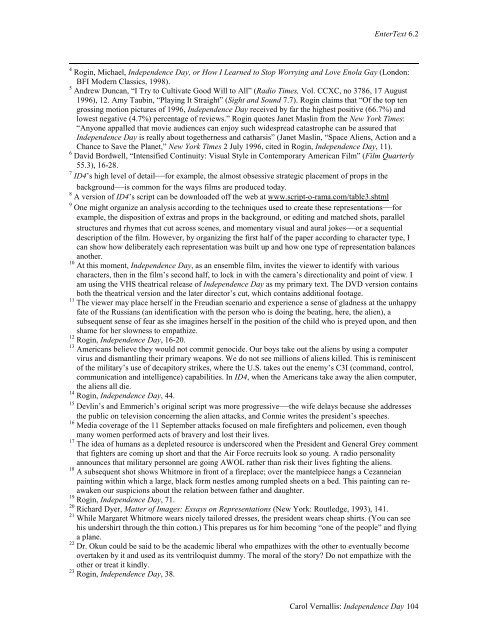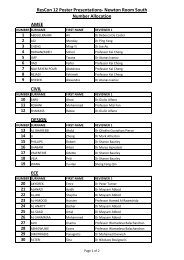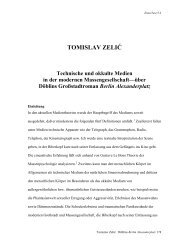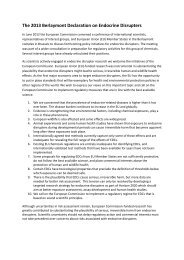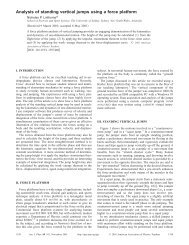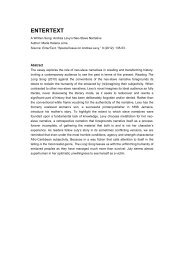Militarism, Misanthropy and the Body Politic: - Brunel University
Militarism, Misanthropy and the Body Politic: - Brunel University
Militarism, Misanthropy and the Body Politic: - Brunel University
You also want an ePaper? Increase the reach of your titles
YUMPU automatically turns print PDFs into web optimized ePapers that Google loves.
EnterText 6.2<br />
4<br />
Rogin, Michael, Independence Day, or How I Learned to Stop Worrying <strong>and</strong> Love Enola Gay (London:<br />
BFI Modern Classics, 1998).<br />
5<br />
Andrew Duncan, “I Try to Cultivate Good Will to All” (Radio Times, Vol. CCXC, no 3786, 17 August<br />
1996), 12. Amy Taubin, “Playing It Straight” (Sight <strong>and</strong> Sound 7.7). Rogin claims that “Of <strong>the</strong> top ten<br />
grossing motion pictures of 1996, Independence Day received by far <strong>the</strong> highest positive (66.7%) <strong>and</strong><br />
lowest negative (4.7%) percentage of reviews.” Rogin quotes Janet Maslin from <strong>the</strong> New York Times:<br />
“Anyone appalled that movie audiences can enjoy such widespread catastrophe can be assured that<br />
Independence Day is really about toge<strong>the</strong>rness <strong>and</strong> catharsis” (Janet Maslin, “Space Aliens, Action <strong>and</strong> a<br />
Chance to Save <strong>the</strong> Planet,” New York Times 2 July 1996, cited in Rogin, Independence Day, 11).<br />
6<br />
David Bordwell, “Intensified Continuity: Visual Style in Contemporary American Film” (Film Quarterly<br />
55.3), 16-28.<br />
7<br />
ID4’s high level of detail—for example, <strong>the</strong> almost obsessive strategic placement of props in <strong>the</strong><br />
background—is common for <strong>the</strong> ways films are produced today.<br />
8<br />
A version of ID4’s script can be downloaded off <strong>the</strong> web at www.script-o-rama.com/table3.shtml<br />
9<br />
One might organize an analysis according to <strong>the</strong> techniques used to create <strong>the</strong>se representations—for<br />
example, <strong>the</strong> disposition of extras <strong>and</strong> props in <strong>the</strong> background, or editing <strong>and</strong> matched shots, parallel<br />
structures <strong>and</strong> rhymes that cut across scenes, <strong>and</strong> momentary visual <strong>and</strong> aural jokes—or a sequential<br />
description of <strong>the</strong> film. However, by organizing <strong>the</strong> first half of <strong>the</strong> paper according to character type, I<br />
can show how deliberately each representation was built up <strong>and</strong> how one type of representation balances<br />
ano<strong>the</strong>r.<br />
10<br />
At this moment, Independence Day, as an ensemble film, invites <strong>the</strong> viewer to identify with various<br />
characters, <strong>the</strong>n in <strong>the</strong> film’s second half, to lock in with <strong>the</strong> camera’s directionality <strong>and</strong> point of view. I<br />
am using <strong>the</strong> VHS <strong>the</strong>atrical release of Independence Day as my primary text. The DVD version contains<br />
both <strong>the</strong> <strong>the</strong>atrical version <strong>and</strong> <strong>the</strong> later director’s cut, which contains additional footage.<br />
11<br />
The viewer may place herself in <strong>the</strong> Freudian scenario <strong>and</strong> experience a sense of gladness at <strong>the</strong> unhappy<br />
fate of <strong>the</strong> Russians (an identification with <strong>the</strong> person who is doing <strong>the</strong> beating, here, <strong>the</strong> alien), a<br />
subsequent sense of fear as she imagines herself in <strong>the</strong> position of <strong>the</strong> child who is preyed upon, <strong>and</strong> <strong>the</strong>n<br />
shame for her slowness to empathize.<br />
12<br />
Rogin, Independence Day, 16-20.<br />
13<br />
Americans believe <strong>the</strong>y would not commit genocide. Our boys take out <strong>the</strong> aliens by using a computer<br />
virus <strong>and</strong> dismantling <strong>the</strong>ir primary weapons. We do not see millions of aliens killed. This is reminiscent<br />
of <strong>the</strong> military’s use of decapitory strikes, where <strong>the</strong> U.S. takes out <strong>the</strong> enemy’s C3I (comm<strong>and</strong>, control,<br />
communication <strong>and</strong> intelligence) capabilities. In ID4, when <strong>the</strong> Americans take away <strong>the</strong> alien computer,<br />
<strong>the</strong> aliens all die.<br />
14<br />
Rogin, Independence Day, 44.<br />
15<br />
Devlin’s <strong>and</strong> Emmerich’s original script was more progressive—<strong>the</strong> wife delays because she addresses<br />
<strong>the</strong> public on television concerning <strong>the</strong> alien attacks, <strong>and</strong> Connie writes <strong>the</strong> president’s speeches.<br />
16<br />
Media coverage of <strong>the</strong> 11 September attacks focused on male firefighters <strong>and</strong> policemen, even though<br />
many women performed acts of bravery <strong>and</strong> lost <strong>the</strong>ir lives.<br />
17<br />
The idea of humans as a depleted resource is underscored when <strong>the</strong> President <strong>and</strong> General Grey comment<br />
that fighters are coming up short <strong>and</strong> that <strong>the</strong> Air Force recruits look so young. A radio personality<br />
announces that military personnel are going AWOL ra<strong>the</strong>r than risk <strong>the</strong>ir lives fighting <strong>the</strong> aliens.<br />
18<br />
A subsequent shot shows Whitmore in front of a fireplace; over <strong>the</strong> mantelpiece hangs a Cezanneian<br />
painting within which a large, black form nestles among rumpled sheets on a bed. This painting can reawaken<br />
our suspicions about <strong>the</strong> relation between fa<strong>the</strong>r <strong>and</strong> daughter.<br />
19<br />
Rogin, Independence Day, 71.<br />
20<br />
Richard Dyer, Matter of Images: Essays on Representations (New York: Routledge, 1993), 141.<br />
21<br />
While Margaret Whitmore wears nicely tailored dresses, <strong>the</strong> president wears cheap shirts. (You can see<br />
his undershirt through <strong>the</strong> thin cotton.) This prepares us for him becoming “one of <strong>the</strong> people” <strong>and</strong> flying<br />
a plane.<br />
22<br />
Dr. Okun could be said to be <strong>the</strong> academic liberal who empathizes with <strong>the</strong> o<strong>the</strong>r to eventually become<br />
overtaken by it <strong>and</strong> used as its ventriloquist dummy. The moral of <strong>the</strong> story? Do not empathize with <strong>the</strong><br />
o<strong>the</strong>r or treat it kindly.<br />
23<br />
Rogin, Independence Day, 38.<br />
Carol Vernallis: Independence Day 104


